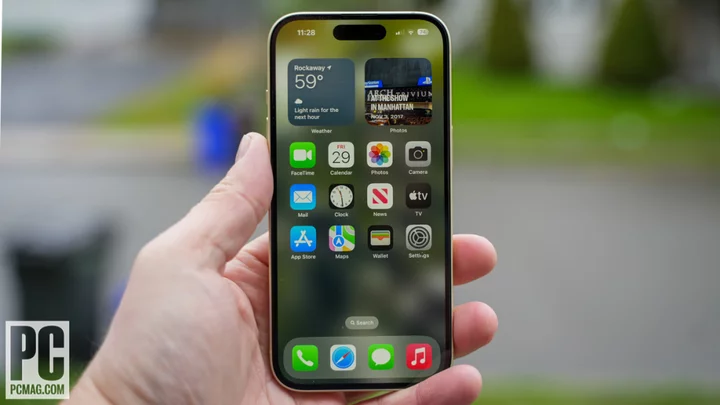Subtle tweaks, most of which are under the hood, add up to a compelling upgrade for the iPhone 15 (starting at $799). While the base model doesn't have the same wow factor as the Pro variants, it features a tweaked design, new display tools, an appreciable jump in performance, and a solid set of cameras at a price that's hard to ignore. The larger 15 Pro Max (starting at $1,199) ultimately earns our Editors' Choice award for pushing the iPhone line forward with its mix of advanced features and top performance, but the iPhone 15 brings you a relatively similar experience in a smaller form factor for a much lower price.
Taking the Edge Off
The vanilla iPhone sees more changes this year than it did last year, but its evolution falls short of what Apple brings to the Pro line. It features the same new shape and USB-C port as the iPhone 15 Pro, but keeps the materials and most everything else the same.
(Credit: Eric Zeman)The iPhone 15 is a simple phone with a clean design that has settled into middle age (for a phone). The biggest difference over the iPhone 14 ($699) is the slightly curved edges of the aluminum frame where it meets the front and rear glass panels. Rather than form sharp right angles, the joints are a little softer all the way around, making it a nicer device to hold day in and day out. Apple used a new process to infuse color directly into the rear glass and adjusted the available selection to matte Black and pastel shades of Blue, Green, Pink, or Yellow.
The phone measures 5.81 by 2.82 by 0.31 inches (HWD) and weighs 6.02 ounces, which is 0.03 inches taller and 0.05 ounces lighter than the iPhone 14. The $899 iPhone 15 Plus, which is larger but otherwise has similar specs, measures 6.33 by 3.06 by 0.31 inches and weighs 7.09 ounces, while the similarly sized but more powerful $999 iPhone 15 Pro measures 5.77 by 2.78 by 0.32 inches and weighs 6.6 ounces. On the Android front, the $799 Samsung Galaxy S23 is the closest at 5.8 by 2.8 by 0.3 inches, 5.9 ounces, and the $599 Pixel 7 measures 6.1 by 2.9 by 0.3 inches and weighs 6.9 ounces.
(Credit: Eric Zeman)As you might expect, the build quality of the iPhone 15 is excellent. The external parts are assembled tightly. Apple protects the display with its homemade Ceramic Shield and uses a textured matte glass to cover the battery. The company says its glass is stronger than the Corning Gorilla Glass Victus or Victus+ you'll find on the Galaxy S23 or Pixel 7. The phone is certified with the IP68 rating for protection against dust and water. The majority of devices in this price range carry the same rating, which means they're able to survive a 30-minute bath in up to 18 feet of water. Despite the matte finish of the rear panel, the phone is still somewhat slippery and you'll be well served by a protective case.
The iPhone 15 doesn't get the awesome Action button of the Pro models. Instead, it keeps the same ringer switch that's been built into every iPhone since 2007. It also keeps the separate volume toggles below the ringer switch and the power/screen lock button on the right edge. The buttons are all top-notch when it comes to travel and feedback.
Top to bottom: iPhone 14 with Lightning, iPhone 15 with USB-C (Credit: Eric Zeman)Apple's proprietary Lightning port no longer graces the bottom edge. Instead, you'll find a USB-C port. For some this change is long overdue, while those still invested in Lightning accessories may find it a burden. Many Apple devices have already made the transition to USB-C and the iPhone is one of the last. The iPhone 15 and 15 Plus support USB 2.0, which is limited to data transfer speeds of 480Mbps. The 15 Pro and Pro Max get a speedier version of USB-C that supports data speeds up to 10Gbps, as well as advanced features such as direct video recording to external hard drives. The iPhone 15 and 15 Plus are able to use an Apple adapter for video mirroring and video out support up to 4K through DisplayPort-to-USB-C.
A Dynamic (But Slow) Screen
The big change to the iPhone 15's screen this year is the adoption of Apple's Dynamic Island. Yes, the base iPhone finally loses the much-maligned notch for the more seamless screen experience first introduced on the iPhone 14 Pro models in 2022. The Dynamic Island is the screen area that surrounds the TrueDepth selfie camera and the Face ID camera used for unlocking the phone. It offers dynamic content on an app-by-app basis for monitoring your music, active Uber trips, timers, flight notifications, and more. The base iPhones don't, however, gain access to the Pro line's always-on display.
(Credit: Eric Zeman)The iPhone 15's Super Retina XDR OLED display measures the same 6.1 inches across the diagonal, but packs in a few more pixels at 2,556 by 1,179 for a density of 460ppi. The iPhone 15 Plus display is bigger at 6.7 inches, but its 2,796 by 1,290 pixels means it has the same density of 460ppi. Both screens carry over a two-million-to-one contrast ratio, but the brightness numbers now stand at 1,000 nits of brightness (typical), 1,600 nits (HDR), and 2,000 nits (peak outdoor). Last year's entry-level iPhone had a maximum brightness of 1,200 nits, so this is a nice change and puts the iPhone 15's screen in the same league as that of the iPhone 15 Pro models, at least in terms of brightness.
The refresh rate is unchanged at 60Hz. The Pro models feature an adaptive refresh rate that ranges from 1Hz to conserve power up to 120Hz for better experiences. And generally speaking, the majority of Android smartphones below the $500 mark (such as the $449 Google Pixel 7a) have upgraded to 90Hz displays, while those above $800 (such as the $799 Galaxy S23) are largely at 120Hz. The quicker refresh rate leads to a cleaner experience when scrolling through apps and menus.
As for everyday usability, the iPhone 15's screen is absolutely fine. People coming from an older iPhone will surely be delighted by the Dynamic Island upgrade and won't notice the outdated 60Hz refresh rate. The display is definitely easier to see under direct sun and looks great for playing back your favorite content thanks to its support for Wide P3 color and HDR.
Above-Average Performance
The new cadence for standard iPhone models is to receive the chip from the previous year's Pro line. That means the iPhone 15 and 15 Plus gain the A16 Bionic from the iPhone 14 Pro and Pro Max. The A16 Bionic relies on a 4nm process while the new A17 Pro of the 15 Pro line relies on a 3nm process. The A16 has a six-core arrangement, with two performance cores at 3.46GHz and four efficiency cores at an unknown clock speed. It includes a five-core GPU and a 16-core Neural Engine. The phone carries over the 6GB of LPDDR5x RAM of the iPhone 14. It comes in 128GB ($799), 256GB ($899), and 512GB ($1,099) variants, which should be enough storage to satisfy most users. There's no expandable storage.
Though the internals are recycled from previous devices, the base iPhone line sees a massive jump in performance thanks to the power of the A16.
(Credit: 3DMark, Geekbench, GFXBench)Starting with Geekbench 6, which rates raw CPU power, the iPhone 15 scored 2,607 on the single-core test and 6,231 on the multi-core test. That's a dramatic improvement over the iPhone 14's scores of 1,753 and 4,734 for the single- and multi-core tests on Geekbench 5.5. It's also much better than the Galaxy S23, which hit 1,541 and 4,949 on Geekbench 5.5. The outgoing Pixel 7 reached only 1,032 and 2,749 (though it will soon be replaced by the presumably faster Pixel 8).
The improvement in graphics is more modest. We ran the GFXBench Aztec Ruins, T-Rex, and Manhattan benchmarks where the iPhone 15 averaged 60fps, a slight tick up from the 58fps of the iPhone 14 and Galaxy S23, and equal to the 60fps of the iPhone 15 Pro Max.
Ratings from other benchmark apps include 3,004 on the 3DMark Wildlife Extreme test, 1,275 on the BaseMark Web 3.0 test, and 1,432,180 on AnTuTu. These scores all outpace those of the iPhone 14 by a decent margin. It's worth noting the phone got warm while running these tests, but not distressingly so. The larger iPhone 15 Plus has the same processor and other specs and puts up similar performance.
In real-world testing, the iPhone 15 powered through tough games like Genshin Impact even when set to the game's highest settings. The phone breezed through a handful of simpler games from Apple Arcade. Regular iOS apps like the camera, Apple Maps, Apple News, and Safari all ran flawlessly.
Keep in mind, iPhones typically run faster for longer than competing Android phones and the iPhone 15 will maintain its performance edge over time.
Small Battery Steps
The base iPhone 15 has a 3,349mAh battery compared with the 3,227mAh power cell of the iPhone 14. That extra 122mAh nets a total of 30 additional minutes of power in our battery tests.
To test battery life, we crank the display's brightness up all the way and stream HD video over Wi-Fi until the phone gives up the ghost. Apple says its iPhone 15 can play video for 16 hours in this test and that's exactly what we got. Sixteen hours is a small half-hour improvement over the iPhone 14, but we'll take it. Competing phones are all over the map—the 15 Pro Max reached 20 hours and 15 minutes, the Galaxy S23 lasted 13 hours and 12 minutes, the Pixel 7 held on for 12 hours and 10 minutes, and the OnePlus 11 5G ran for 11 hours and 13 minutes in the same test.
(Credit: Eric Zeman)Out in the real world, the iPhone 15 gets through a full day with some power to spare, but not much. The larger 15 Plus is rated to run a few hours longer, so if battery life is important (and you like a larger phone), that might be the better option for you.
The iPhone 15 and 15 Plus both support 20W wired charging. Like the Pro models, there's no charging brick in the box, but the phones do come with a really nice 39-inch braided USB-C-to-USB-C cable. The S23 and Pixel 7 charge at about the same rate (25W), but the $699.99 OnePlus 11 5G charges much faster (80W).
Apple says the iPhone 15 can charge from 0 to 50% in 30 minutes but we clocked it at 32 minutes. It took about 85 minutes to reach a full charge, which is the same as the iPhone 15 Pro Max and iPhone 14. For the sake of comparison, the S23's charging time ran 71 minutes and the OnePlus 11 5G needed just 27 minutes.
You can use Apple's MagSafe wireless charging accessories to charge the phone at 15W. Doing so takes a little under two hours to charge the phone fully. Regular Qi wireless chargers also work but at a slower rate of 7.5W.
Better Phone Calls
Apple keeps the iPhone 15's radios largely in line with those of the Pro models, though there are a few specs where it lags.
Starting with 5G, the iPhone 15 uses the same Qualcomm Snapdragon X70 modem, which means the latest in terms of C-band, sub-6GHz, and mmWave support for the three major carriers. We tested the iPhone 15 on AT&T's 5G network in and around New York City and saw much better performance than we did on last year's iPhone 14. Download speeds over a strong AT&T 5G+ connection reached an incredible 630Mbps, with peak uploads at 65Mbps. When tested in an area with weak AT&T service, it netted slower rates of 35Mbps down and 11Mbps up, but it still maintained a connection.
(Credit: Eric Zeman)Disappointingly, the iPhone 15 carries over the iPhone 14's Wi-Fi 6 radio rather than jumping to Wi-Fi 6E, which both 15 Pro models adopt this year. We saw slower maximum Wi-Fi speeds as a result. For example, the iPhone 15 maxed out at 597Mbps down when tested right next to a Verizon Fios router with 1 gig service, while the 15 Pro Max reached 640Mbps from the same spot. Wi-Fi upload speeds, however, were improved to 258Mbps compared with 239Mbps for the 15 Pro Max and 209Mbps for the 14 Pro Max. The phone was still serviceable at the Wi-Fi network's edge, where it peaked at 7Mbps down.
For connecting to accessories, the iPhone 15 has Bluetooth 5.3. This is the latest spec and helps devices maintain stronger connections while drawing less battery power. Codec support remains the same: AAC, Apple Lossless, and FLAC, in addition to support for Apple's spatial audio. When tested with true wireless earbuds, the connection remained strong.
The iPhone 15 line does not gain support for the Thread smart home networking standard, which both the iPhone 15 Pro and 15 Pro Max have.
As we noted in our review of the 15 Pro Max, the entire iPhone 15 family is eSIM-only for models sold in the US. You can have up to two separate numbers active at once and store up to eight others on the phone. AT&T helped provision the iPhone 15 remotely and it was a cinch to sit back and let it happen over the air.
When testing calls over AT&T's network, every conversation was loud and clear. There were no pops or hisses in the earpiece, which delivered clean audio that was loud enough to hear at home and when out and about. Apple's Voice Isolation feature, which you need to turn on, negates background buzz and makes your voice stand out more. We suggest turning it on.
(Credit: Eric Zeman)The iPhone 15's stereo speakers are quite good. Whether you're listening to some tunes in the background or catching up on YouTube videos at the end of the day, you get plenty of punch and volume from the separate speakers. Our bass test track, The Knife's "Silent Shout," exhibited rich, clear highs and enough bass for a smartphone. If you need to fill more space than a bedroom or small office, you'll likely prefer a Bluetooth speaker.
All iPhone 15 models gain two years of access to a new safety service called Emergency Roadside Assistance. Similar to Emergency SOS, it is meant to help people who find themselves in trouble outside of normal cellular coverage. Using the iPhone 15, you can send text messages via satellite to a local call center. It pairs you with a local AAA provider, which can be dispatched to perform services like tows. Making the connection to AAA via the Emergency Roadside Assistance feature is free, but tows and other services will likely carry a fee for those who don't subscribe to AAA.
Sharper Shots
All four iPhone 15 models include the same 48MP main camera sensor, which is nice to see, though the standard 15 and 15 Plus have fewer camera features.
Often, a 48MP smartphone camera sensor will be binned down by a factor of four to generate 12MP photos. Apple is thinking differently. It's taking a full 48MP shot and blending it with a 12MP binned photo to create a final 24MP image. The idea is to preserve the fine detail you get from the full pixel count with the brighter low-light results you get from a binned shot. iPhone 15 owners can save photos in HEIF or jpeg formats, but not ProRAW like the 15 Pro and Pro Max can.
(Credit: Eric Zeman)This year, the iPhone 15's camera can snap 2x "optical" zoom photos even though it doesn't have a telephoto lens. Apple is accomplishing this by shooting with the central 12MP of the sensor and then polishing it with some software. Apple says this technique delivers 2x pictures that are as clear as if they were shot through a 2x lens.
The second rear sensor is a 12MP ultra-wide camera at f/2.4. This wide-angle shooter takes 0.5x photos that capture huge vistas and is great for street photography or indoor settings. The ultra-wide camera does not support macro photography like it does on the Pro models, nor do the iPhone 15 and 15 Plus have the optical telephoto camera of the Pro models. However, the 12MP TrueDepth selfie camera is the same across all four iPhones. It has an aperture of f/1.9 and supports Deep Fusion, Night Mode, Photographic Styles, Portrait Lighting, and Smart HDR 5.
(Credit: Eric Zeman) (Credit: Eric Zeman)Photos taken with both cameras are quite good. I was particularly pleased with the shots from the main camera taken during the day. They demonstrate excellent color and clarity while keeping the HDR adjustments in check.
(Credit: Eric Zeman) (Credit: Eric Zeman)The ultrawide sensor does introduce some optical distortion, but that's fairly typical for smartphone lenses. Still, the resulting images are often fun thanks to their perspective and they come out with nice color and focus.
(Credit: Eric Zeman) (Credit: Eric Zeman)Some nighttime shots came out spectacularly well. The photo of the Statue of Liberty below was taken with deep zoom on a rocking boat, which makes the sharpness and exposure all the more impressive.
(Credit: Eric Zeman) (Credit: Eric Zeman)Selfies and portraits are solid, though I think they could be a bit sharper. Speaking of portraits, all iPhone 15 models capture depth information when the phone detects a person, dog, or cat so you can add the portrait effect later if you wish. I found it works well with people, but otherwise can be a little hit-or-miss.
(Credit: Eric Zeman) (Credit: Eric Zeman)The iPhone 15 and 15 Plus can perform most of the same video-capture tricks that the Pro models can, minus ProRes, Log, and Macro recording. Otherwise, you get access to 4K60 from all three cameras with Action mode, Cinematic mode, and Dolby Vision. The footage looks excellent. The iPhone has long been one of the leading smartphones for video capture and even the less-feature-rich iPhone 15 beats many Android phones.
iOS 17 Standing By
The iPhone 15 comes with iOS 17 preloaded. We suggest you read our in-depth review for information on all the new stuff inside.
One of our favorite additions is Standby mode, which essentially converts your iPhone into a smart display. You have to plug it in and set it on its side to activate Standby mode, but then your phone can display two widgets side by side. Available widgets include batteries, a calendar, a clock, news headlines, a reading list, reminders, and the weather. It's a great deskside or bedside companion.
You can rest easy knowing that Apple will support the iPhone 15 with software and security updates for at least five years. In comparison, Android smartphones typically receive two to four years of OS and security updates.
The Most Sensible iPhone
The iPhone 15 is an excellent smartphone that includes all but the most advanced features. Its speedy performance, bright display, and sharp cameras make it an easy recommendation for anyone upgrading from an iPhone 12 or iPhone 13. It's also a good choice for a starter iPhone, bringing you strong performance and everything else you expect from an iPhone for a relatively reasonable price. Ultimately, the $1,199 iPhone 15 Pro Max is our Editors' Choice winner thanks to its everything-and-the-kitchen-sink approach. But the base iPhone 15 is good enough that you won't feel like you're missing out.









